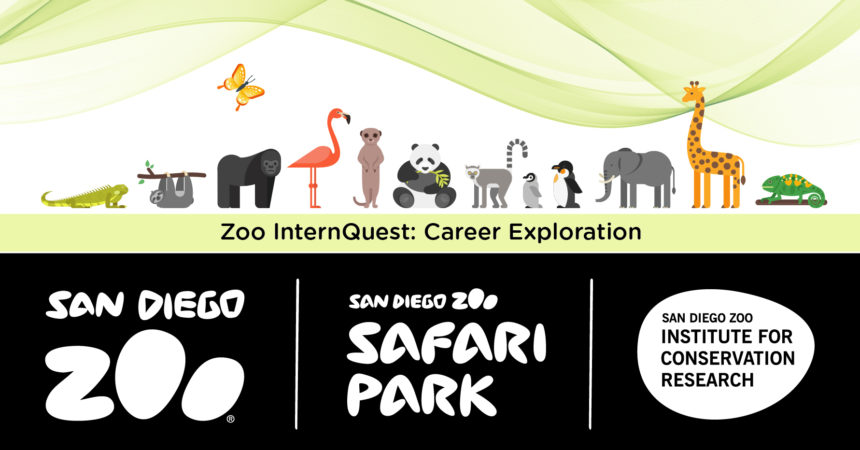Zoo Internquest is a seven-week career exploration program for San Diego County high school juniors and seniors. Students have the unique opportunity to meet professionals working for the San Diego Zoo, Safari Park, and Institute for Conservation Research, learn about their jobs, and then blog about their experience online. Follow their adventures here on the Zoo’s website!

While some can only dream of visiting the beautiful and unique forests of Australia, Ms. Tobey has turned this dream into an exciting and rewarding career! This week my fellow interns and I met with Jennifer Tobey who is an Animal Behaviorist as well as a Researcher for the Institute for Conservation Research at the San Diego Zoo. The Institute for Conservation Research largely focuses on breeding and reproductive sciences but is also involved in more hands-on research in animals’ natural habitats. Working in the Population Sustainability Team at the Institute, Ms. Tobey focuses on animals in their natural habitats, as well as the unique animals in the Zoo’s collection, in order to monitor their behavior and populations in the wild. These observations are then applied to the Zoo’s many conservation projects to guide the way and help identify the most beneficial course of action to preserve as many species of animals as possible.
Before pursuing a career in animal-based research, Ms. Tobey attended Franklin & Marshall College and graduated with an undergraduate’s degree in biology and psychology and minored in anthropology. Ms. Tobey then went on to earn her masters at Cal State San Marcos in comparative psychology which focuses on the behavior and mental processes of non-human animals. After deciding to become a researcher, Ms. Tobey took a special interest in koalas and has been working with them for about 18 years. Ms. Tobey began research with San Diego’s famous collection of koalas at the Zoo and monitored their day-to-day behaviors. These observed behaviors can then be compared to the behavior of koalas in the wild. While monitoring the behavior of the Zoo’s koalas, Ms. Tobey took note of their seasonal breeding patterns, the unique vocalization of the males, as well as the scent given off by the males during the breeding season in order to attract mates. Ms. Tobey’s research, as well as her love for koalas, drove her to participate in collaboration with Australian researchers to expand their knowledge of the species in the koala’s native country.
Participating in a project known as the Blue Mountains Koala Project, Ms. Tobey worked with other researchers in Australia’s Blue Mountains, located west of Sydney, in order to observe and track a native population of koalas. This population of koalas was decimated by koala hunts that took place in the area and it is therefore important to keep an eye on the population and monitor its recovery. Working alongside Dr. Kellie Leigh, a field researcher who started the project, Ms. Tobey helped to find and tag multiple koalas in order to monitor their future activity as well as monitor the status of their population. However, finding koalas in the wooded forests of Australia proved to be very difficult and required the effort of many researchers and even a couple of professional tree climbers!
Koalas sleep anywhere from 18 to 22 hours a day and therefore are almost always found in the canopy of trees above the forest floor. Ms. Tobey and her fellow koala researchers worked alongside professional tree climbers in order to ensure that they would be able to capture, tag, and release the koalas they found while navigating the Blue Mountains. The most common way the koalas were brought down from the tops of the trees in the forest was through a process known as flagging. During this process, an object is dangled over the koala’s head and coaxes the koala to climb down the tree. Once at the base of the tree, the koala is bagged in order to restrain it while Ms. Tobey and the other researchers conduct tests and make observations. These tests often include measurements, weight recording, skin samples, tagging, and the attachment of a tracking collar to the neck of the koala. The koala is then released at the base of the exact tree that the researchers coaxed it out of in order to not confuse the animal or interfere with its natural processes. By observing and tagging the many koalas that Ms. Tobey and her team of researchers find, they are able to monitor these koala populations as well as advance the research behind conservation efforts that are working to save this amazing species.
When discussing her career as an animal behaviorist and researcher, Ms. Tobey expressed that flexibility, motivation in academics, and patience are all essential skills in her field of work. By building a strong foundation with volunteer hours and a commitment to academics, Ms. Tobey was able to pursue a dream career that is not only meaningful and rewarding, but the opportunity of a lifetime. Ms. Tobey expressed that the most rewarding part of her job is the ability to educate people and encourage them to take up an interest in something that you’re passionate about. Please continue to read the blogs that my fellow interns and I post each week and continue alongside us on this amazing and unforgettable journey!
Cole, Careers Team
Week Three, Winter Session 2019


